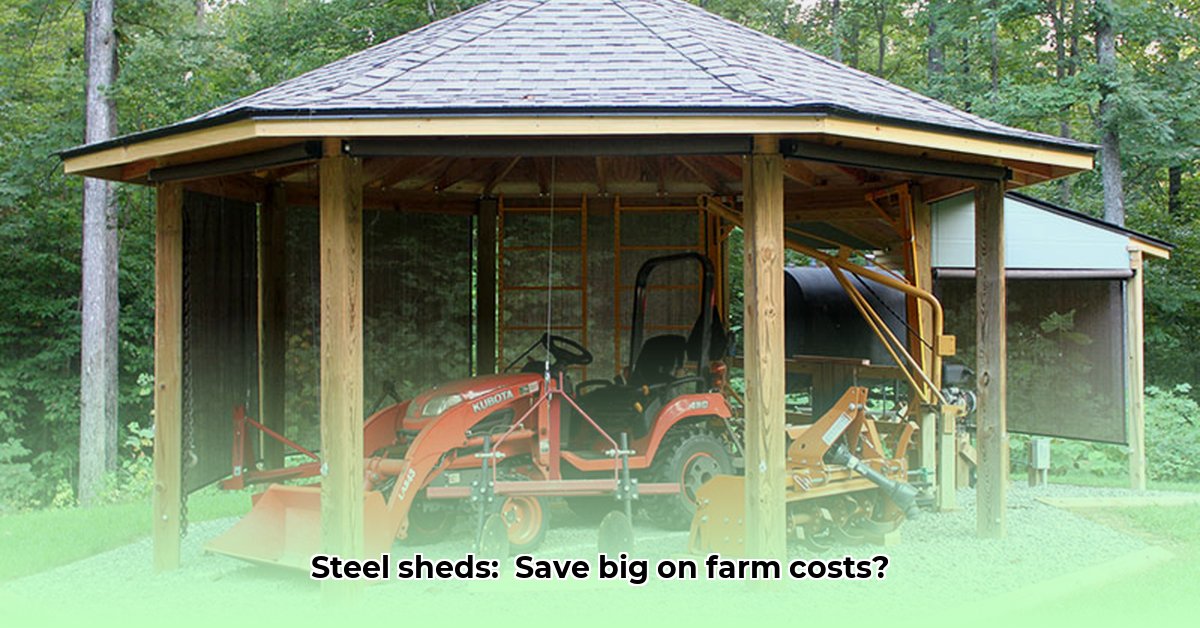
Protecting your valuable farm equipment is paramount. This guide explores why a metal tractor shed represents a superior long-term investment compared to a wooden structure, examining costs, lifespan, maintenance, and environmental impact. We'll provide a step-by-step guide to building your own metal shed, ensuring you're equipped to make a smart, sustainable choice that safeguards your investment and contributes to your farm's overall profitability. For more detailed information on metal shed designs, check out this helpful resource: Metal Shed Designs.
Tractor Sheds: Steel vs. Wood – A Comparative Analysis
The choice between a metal and wood tractor shed significantly impacts long-term farm economics and sustainability. While initial costs may seem higher for steel, the extended lifespan and reduced maintenance translate into substantial long-term savings. A well-maintained steel shed can easily outlast a wooden counterpart, offering a greater return on investment over its operational lifetime.
Metal vs. Wood: A Detailed Comparison
The following table directly compares key factors influencing the selection of a tractor shed material:
| Feature | Steel Tractor Shed | Wood Tractor Shed |
|---|---|---|
| Initial Cost | Higher upfront investment | Lower initial cost |
| Maintenance | Minimal (occasional cleaning and rust prevention) | Significant (regular painting, staining, repairs for rot and damage) |
| Lifespan | Potentially decades, depending on care | Typically 15-20 years, subject to climate and maintenance |
| Environmental Impact | Recyclable steel; potentially lower carbon footprint with recycled materials | Deforestation concerns; more frequent replacements contribute to higher environmental impact |
| Customization | Highly customizable to fit your specific needs | More limited customization options |
| Insurance Costs | Likely lower due to longevity and durability | Possibly higher due to higher risk of damage and shorter lifespan |
Isn't it remarkable how the seemingly minor upfront cost difference can balloon into substantial savings over the decades? This underscores the importance of calculating the Total Cost of Ownership (TCO) before making your decision.
Factors Influencing Your Choice: Beyond the Initial Investment
While the cost comparison is crucial, several other elements influence the optimal shed choice. These factors require careful consideration to ensure the selected structure meets your specific needs and farm specifications.
Farm Size and Equipment: A larger farm requires a proportionally larger shed to accommodate all equipment, plus potential space for maintenance or repair. Proper space planning prevents future capacity limitations.
Climate: Harsh weather conditions (heavy snowfall, extreme temperatures, high winds) necessitate a robust, durable structure. Steel's inherent strength provides superior protection against these elements compared to wood.
Local Building Codes and Permits: Familiarize yourself with local regulations before initiating construction. Failure to comply with building codes can lead to costly fines and delays.
Equipment Specific Needs: Consider the unique features your equipment may require – ventilation for specific machinery, electrical outlets for tools, additional security measures, etc.
Planning and Building Your Metal Tractor Shed: A Step-by-Step Guide
Constructing a metal tractor shed involves a series of logical, manageable steps. Thorough planning minimizes errors and ensures a successful outcome.
Site Selection and Preparation: Identify a level, well-drained location. Clear any vegetation and debris, ensuring a stable foundation.
Determining Size and Features: Accurately assess your current and future equipment storage needs. This ensures the shed adequately accommodates your farm's growth.
Obtaining Necessary Permits: Strictly follow all local building codes and obtain the required permits before commencing construction. This prevents potentially costly setbacks.
Selecting Reputable Manufacturers and Installers: Thoroughly research manufacturers and installers, comparing quotes, reading reviews, and verifying their expertise. A qualified installer ensures quality workmanship.
Budgeting and Securing Financing: Develop a detailed budget, including all costs (materials, labor, permits). Explore financing options if necessary.
Maintenance and Long-Term Care: Protecting Your Investment
Regular maintenance significantly extends the lifespan of your metal shed. A minimal effort ensures long-term cost savings and prevents unforeseen repair expenses.
Regular Inspections: Conduct periodic inspections to identify and address any potential issues (rust, damage, etc.) promptly.
Cleaning: Regularly clean the exterior to prevent dirt and debris buildup, minimizing corrosion.
Rust Prevention: Apply a rust-resistant coating as needed, significantly extending the shed's lifespan and protecting your investment.
Environmental Considerations: Sustainability and Steel
Steel's inherent recyclability contributes to a lower environmental impact compared to wood. Utilizing recycled steel in your shed's construction further minimizes its carbon footprint, aligning with sustainable agricultural practices. However, it's important to also consider the manufacturing process and transportation impacts to gain a holistic view.
Conclusion: A Wise Investment for a Thriving Farm
Investing in a steel tractor shed may present a higher upfront cost, but the long-term benefits – reduced maintenance, extended lifespan, and potential environmental advantages – make it a financially sound and environmentally responsible choice. It’s an investment that reflects your commitment to both your farm's long-term prosperity and environmental stewardship. This is more than just a shed; it’s a strategic investment in the future of your operation.
Resources
(Note: This section would ideally contain links to relevant organizations, manufacturers, and regulatory bodies. Due to limitations of this response format, specific links cannot be provided.)